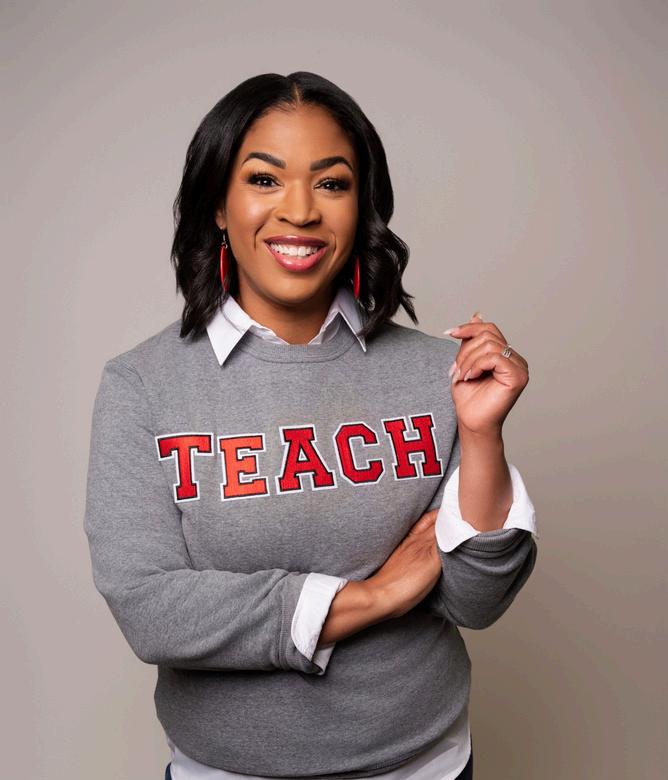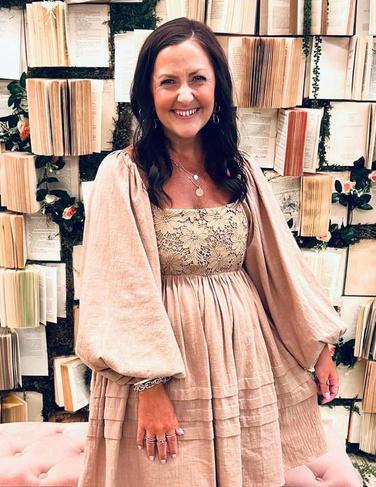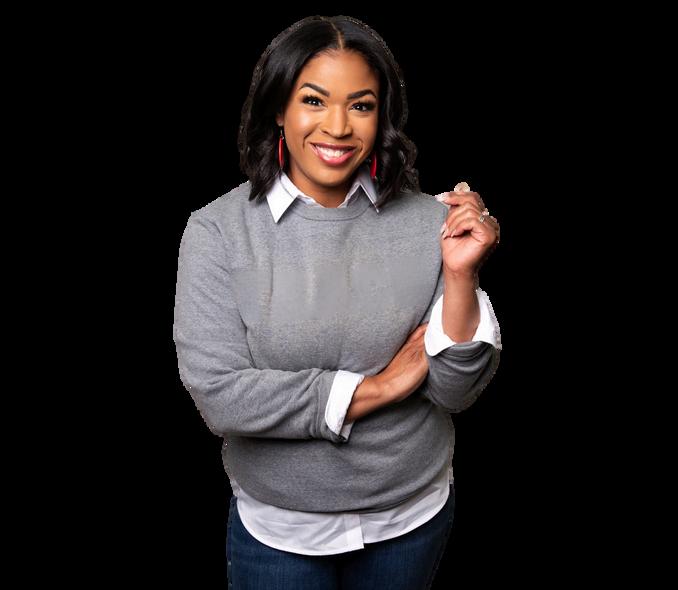2 N D G R A D E CONFERENCE GUIDE
June 29- July 2, 2025 | Dallas, TX | Gaylord Texan Resort

2 N D G R A D E CONFERENCE GUIDE
June 29- July 2, 2025 | Dallas, TX | Gaylord Texan Resort

A N O T E F R O M O U R F O U N D E R S
Dear GYTO National Attendees,
As we gear up for the highly anticipated 2025 GYTO National Conference, we are thrilled to welcome each of you to this transformative event The GYTO community is a powerhouse of passionate educators, and we are honored to come together with those ready to make bold moves that create real, actionable change in education.
This year, our theme is "Make Bold Moves." As educators, it’s time to go beyond dreaming and talking about change—it’s time to act. Bold moves require courage, vision, and a commitment to challenging the status quo to build better opportunities for our students and ourselves. This theme represents the actionable steps we take to innovate, advocate, and elevate our practices for the betterment of education as a whole.
Bold moves are not just individual efforts they are the result of a collective will to progress. Together, at the 2025 National Conference, we’ll explore how to identify barriers, take purposeful action, and amplify the impact of our efforts. This is your chance to share your journey, learn from others, and forge the connections that will propel us all forward.
The conference will feature dynamic speakers who will inspire you to take action, interactive workshops designed to equip you with tangible tools, and game-changing insights that will push you to think differently. You can also expect unforgettable surprises that will leave you energized and ready to lead boldly.
Let’s commit to taking bold moves together and shaping the future of education one step, one decision, and one classroom at a time. This is your time to move, lead, and create meaningful impact.
We can’t wait to see you in Dallas, June 29 - July 2, 2025, as we embrace this call to action and transform our passion into progress Let’s take the steps that will define the future of education— together.
With excitement and anticipation,
Our Get Your Teach On Leadership and Content Development team has worked to create an engaging and transformational educator professional development experience that aligns directly to the needs of schools and teachers across the country by helping educators develop consistent best instructional practices and processes from start to finish to accelerate student learning
These evidence and research-based best practices, strategies, and techniques will directly impact overall educator effectiveness and student achievement, transforming instruction and student learning like never before.
TEACHER EFFECTIVENESS
DATA & PROGRESS MONITORING
Developing Consistent Best Instructional Practices and Processes from Start to Finish to Completely
PLANNING & PREPARATION
THE LEARNING ENVIRONMENT
BEST INSTRUCTIONAL PRACTICES
STUDENT ACCOUNTABILITY & ENGAGEMENT
DATA & PROGRESS MONITORING
TEACHER EFFECTIVENESS
PLANNING & PREPARATION

STUDENT ACCOUNTABILITY & ENGAGEMENT
Intentional and meaningful planning, using specific grade level content standards and high-quality instructional materials that address the needs of all learners and support mastery of learning goals.
Creates and maintains a collaborative, safe, efficient, and effective learning environment that supports each student’s diverse needs and promotes recognition of student’s diverse personal experiences to build relationships of trust within the classroom.
Implementation of evidence and research-based best instructional strategies and techniques to accelerate student learning, growth, and achievement through rigorous and consistent instruction, including opportunities for problem solving, critical and creative thinking, meaningful and purposeful discourse, and high-impact instructional delivery.
Builds engaging, intentional, and rigorous learning experiences through setting high expectations and consistency within instructional practices that requires all students to take ownership of and be held accountable for their individual learning.
Continually monitors and analyzes student learning and progress towards mastery of learning goals for all students using a variety of progress monitoring and assessment techniques to make immediate instructional decisions that support student growth and acceleration.
Develops strong foundational teaching practices and commitments that support best practices and professional growth through consistent reflection of professional practices to support student learning, development, and achievement at a high level.
THE LEARNING ENVIRONMENT
BEST INSTRUCTIONAL PRACTICES
Get Your Teach On sessions are intentionally selected for attendees to experience the full professional development experience. Each session is hands-on, interactive, collaborative, and allows time for teachers to take what they’ve learned and apply it to their specific grade level standards or content area.
Sessions are structured to meet the needs of all learners in classrooms, modeling best practices for direct and immediate implementation in classrooms.

SUNDAY JUNE 29
1 3 4 2
schedule is subject to change MONDAY JUNE 30
12:00-5:00 PM REGISTRATION 5:00 PM
DOORS OPEN FOR GYTO OPENING CELEBRATION & KEYNOTE
6:00-8:30 PM GYTO OPENING CELEBRATION & KEYNOTE
8:00-10:00 AM OPENING KEYNOTE 10:30-11:45 AM SESSION 1 11:45-1:15 PM LUNCH
1:15-2:30 PM SESSION 2
2:45-4:00 PM SESSION 3
4:30-6:00 PM CLOSING KEYNOTE
TUESDAY JULY 1
8:30-10:00 AM OPENING KEYNOTE
10:30-11:45 AM SESSION 1
11:45-1:15 PM LUNCH
1:15-2:30 PM SESSION 2
2:45-4:00 PM SESSION 3
4:30-6:00 PM CLOSING KEYNOTE
WEDNESDAY JULY 2
9:00-10:15 AM SESSION 1 10:30-11:45 PM SESSION 2 11:45-1:15 PM LUNCH 1:30-3:00 PM GYTO CLOSING SESSION YOU DON'T WANT TO MISS THIS! NO MORNING KEYNOTE

Session Presented by: LaNesha Tabb
THE GREAT READING RESCUE 2.0
Session Presented by: ien


THE STAR STRATEGY: SMALL GROUPS THAT STAND OUT ession Presented by: Amelia Capotosta
Session Presented by: Ashley Schroeder



DIFFERENTIATION UNLOCKED
Session Presented by: Stephanie Higgs
MATH IN MOTION: HANDS ON LEARNING FOR 2ND GRADE SUCCESS
Session Presented by: Amy Lemons


MATH FACT MANIA: A SET LIST OF STRATEGIES
Session Presented by: Ashley Schroeder
UNLOCKING STUDENT ENGAGEMENT WITH WHOLE BRAIN TEACHING
Session Presented by: Andre Deshotel




ting the most popular part of your day? In this session, we’ll explore wicked g g p wer second-grade students to develop strong writing skills while seamlessly fitting into your daily teaching routine. Whether you're teaching science, social studies, or even math, you’ll learn how to implement effective writing structures that elevate student engagement and progress.
We'll cover:
Proven frameworks to simplify writing instruction
Strategies that boost confidence and independence in young writers
Ways to integrate writing into any subject area without losing time or focus
By the end of this session, you’ll have a toolkit of flexible, effective approaches to make writing instruction feel effortless and impactful—no magic wand required! Let’s defy the gravity of writing challenges and help your students soar!
§110.4(b)(11)(C): revise drafts by adding, deleting, or rearranging words, phrases, or sentences.
§110.4(b)(11)(D): edit drafts using standard English conventions, including: (i) complete sentences with subject-verb agreement; (ii) past, present, and future verb tense; (iii) singular, plural, common, and proper nouns; (iv) adjectives, including articles; (v) adverbs that convey time; and (vi) prepositions and prepositional phrases
§110.4(b)(11)(D): edit drafts using standard English conventions, including: (i) complete sentences with subject-verb agreement; (ii) past, present, and future verb tense; (iii) singular, plural, common, and proper nouns; (iv) adjectives, including articles; (v) adverbs that convey time; and (vi) prepositions and prepositional phrases.
Graham, S., Bollinger, A., Booth Olson, C., D’Aoust, C., MacArthur, C., McCutchen, D., & Olinghouse, N (2012) Teaching elementary school students to be effective writers.
Graham, S., & Hebert, M. (2011). Writing to read: A meta-analysis of the impact of writing and writing instruction on reading Harvard Educational Review, 81(4), 710-744.
Sedita, J. (2019). The Writing Rope: The Strands That Are Woven into Skilled Writing. Keys to Literacy.
Sedita, J (2022) The Writing Rope: A Framework for Explicit Writing Instruction in All Subjects. Brookes Publishing.



dn’t be higher—3rd grade is around the corner, and your students’ reading skills ossible! Join Naomi for an action-packed session that will equip you with the tools o student leaves behind the foundational skills they need to thrive.
f reading research to:
d phonics lessons that drive results fast.
ogical awareness to build strong, confident readers. and target interventions with laser precision.
e to Accept It):
pping through the cracks before 3rd grade. With urgency, proven strategies, and u defy the odds and ensure your students are ready for success. Let’s get this mission accomplished—because their future depends on it!
You’ll leave with a clear roadmap for turning struggling readers into thriving ones, even in limited time. Naomi will share practical, no-fluff strategies you can start using tomorrow to make measurable progress. It’s not too late to rewrite their story—and this is the mission that changes everything.
§110.4(b)(2):Demonstrateandapplyphoneticknowledgeby: (A)decodingwordswithshort,long,orvariantvowels, trigraphs,andblends;(B)decodingwordswithsilentletters;(C) decodingmultisyllabicwords;(D)decodingcompoundwords, contractions,andcommonabbreviations;(E)decodingwords usingknowledgeofsyllabledivisionpatternssuchasopen, closed,finalstablesyllable,vowel-consonant-e,r-controlled, andvoweldigraphsanddiphthongs;(F)decodingwordsusing knowledgeofprefixes;and(G)identifyingandreadinghighfrequencywordsfromaresearch-basedlist.
§1104(b)(4):Thestudentreadsgrade-leveltextwithfluency andcomprehension Thestudentisexpectedtouseappropriate fluency(rate,accuracy,andprosody)whenreadinggradeleveltext.
§110.4(b)(4):Asnotedabove,thisstandardexpectsstudents touseappropriatefluency,encompassingrate,accuracy,and prosody,whenreadinggrade-leveltext
Hornsby, D. (2015). Why Phonics and Fluency Matter: The Science Behind the Early Development of Reading Skills. Journal of Educational Psychology
Ehri, L. C., Nunes, S. R., Stahl, S. A., & Willows, D. M. (2001). Systematic Phonics Instruction and Children’s Reading Achievement. Review of Educational Research
Eide, D. (2011). The Logic of English: A Comprehensive Guide to Teaching Reading, Writing, and Spelling
Shaywitz, S. E. (2003). Overcoming Dyslexia: A New and Complete Science-Based Program for Reading Problems at Any Level


Channelling the precision and energy of a dynamic team,Amelia will lead you and cheer you on in this engaging professional development session designed to help you create literacy small groups that truly shine! Just like the iconic team thrives on discipline and excellence, your literacy small groups can reach new heights by blending research-based best practices with practical, easy-to-implement strategies.
This session will guide you through the full process of building standout small groups, starting with informal data collection and assessment to pinpoint student needs. Grounded in research and evidence based practices, she’ll show you how to analyze student progress, identify gaps, and form dynamic, fluid groups. Leveraging strategies that are aligned to the Science of Reading, you’ll learn how to:
Organize with Confidence: Set up your small groups using efficient systems to manage rotations, schedules, and materials
Instruct with Impact: Implement evidence-based activities that align with phonics, comprehension, and vocabulary instruction.
Adapt with Ease: Keep groups fluid, adjusting based on ongoing informal assessments and student growth.
By the end of this session, you’ll leave with a plan for small group literacy instruction that is as adaptable and effective as the cheerleaders’ iconic routines helping all your students take center stage in their literacy journey.
Are you ready to craft small groups that stand out and make learning a star-studded success? Join us and make it happen!
§1104(b)(2):Demonstrateandapplyphoneticknowledgeby:(A)decoding wordswithshort,long,orvariantvowels,trigraphs,andblends;(B)decoding wordswithsilentletters;(C)decodingmultisyllabicwords;(D)decoding compoundwords,contractions,andcommonabbreviations;(E)decoding wordsusingknowledgeofsyllabledivisionpatternssuchasopen,closed,final stablesyllable,vowel-consonant-e,r-controlled,andvoweldigraphsand diphthongs;(F)decodingwordsusingknowledgeofprefixes;and(G) identifyingandreadinghigh-frequencywordsfromaresearch-basedlist
§1104(b)(6)(C):Makeinferencesanduseevidencetosupport understanding TEATEXASGOV
§1104(b)(6)(D):Retellandparaphrasetextsinwaysthatmaintainmeaning andlogicalorder
§1104(b)(6)(B):Generatequestionsabouttextbefore,during,andafter readingtodeepenunderstandingandgaininformation. TEATEXASGOV
§1104(b)(6)(C):Makeinferencesanduseevidencetosupport understanding
§1104(b)(5)(B):Usecontextwithinandbeyondasentencetodeterminethe meaningofunfamiliarwords

Shanahan, T. (2023). Teaching practices for improving reading comprehension and literacy skills
Session
Description
ReadWorks. (2021). ReadWorks resources and research-based reading comprehension lessons
CORE. (2020). Teaching reading sourcebook: Core phonics survey. Consortium on Reading Excellence, Inc.
Florida Center for Reading Research. (2022). Evidence-based reading instruction resources and strategies

anagement in this engaging session designed to help you maintain a smooth ly classroom hustle. Like a well-run pizzeria, a thriving classroom depends on ocedures—especially during transitions. Explore strategies to establish inimize disruptions while increasing time on task. Learn how to make transitions r learning and collaboration while boosting student engagement and simultaneously fostering a cohesive classroom environment.
We’ll also focus on student-centered transitions that empower learners to take ownership of their routines, promote responsibility, critical thinking, and self-regulation much like letting them customize their own pizza toppings!
By the closing shift, you’ll have a list of recipes for practical strategies to maximize instructional time, reduce interruptions, and keep students motivated. Let’s transform every transition into a smooth, flavorful moment that fuels curiosity and independence.
Sprick, J., Sprick, R., Edwards, J., Coughlin, C (2021). CHAMPS: A Proactive & Positive Approach to Classroom Management
Franklin, Hayley; Harrington, Ingrid (2019) A Review into Effective Classroom Management and Strategies for Student Engagement: Teacher and Student Roles in Today‟ s Classrooms.


evelopment adventure?! Join Little Miss Gifted, Stephanie Higgs, for an on that’s packed with creative, low-prep differentiation strategies to energize es, crack codes, and uncover powerful tools like stoplight questioning, visual -changing ideas to meet the needs of all learners.
This session combines laughter, learning, and hands-on challenges to keep you engaged from start to finish. You’ll leave with a treasure trove of actionable strategies that are easy to implement and guaranteed to transform your classroom. Escape the ordinary—if you dare—and discover a fresh approach to differentiation that will spark creativity, boost student engagement, and make teaching even more fun. This isn’t just a session; it’s an unforgettable revolution in education that you can’t afford to miss!
Blevins, W. Differentiating phonics instruction for maximum impact: How to scaffold whole-group instruction so all students can access grade-level content. Corwin Literacy.
Engel, Mimi. November 2013. Most math being taught in kindergarten is old news to students. Retrieved from https://news.vanderbilt.edu/2013/11/22/most-math-being-taught-inkindergarten-is-old-news-to-students/
Kircher-Morris, E., & Morin, A. (2025). Neurodiversity-affirming schools: Transforming practices so all students feel accepted and supported. Free Spirit Publishing. ASCD. Mofield, Emily. (2023). Vertical differentiation. Routledge Press.
Reis, Sally. Renzulli, J., Renzulli S.J. 8 October 2021. Enrichment and gifted education pedagogy to develop talents, gifts, and creative productivity. Retrieved from https://files.eric.ed.gov/fulltext/EJ1317646.pdf
Tomlinson, C. (2014). The differentiated classroom: Responding to the needs of all learners.
Zakreski, M. (2024). The neurodiversity playbook: How neurodivergent people can crack the code of living in a neurotypical world. Gifted Unlimited.


Get ready to energize your math instruction with engaging, hands-on activities designed to get your students moving, thinking, and mastering key skills! In this interactive session, you’ll experience activities like Musical Math Mayhem and Poppin’ into Place Value that make learning fun and dynamic.
We'll explore strategies to enhance place value understanding, build fact fluency, and develop confidence in math concepts through movement and collaboration. Walk away with a toolkit of high-energy ideas that will keep your classroom buzzing with excitement and success!
§111 4(b)(2)(A): Use place value to read, write, compare, and order numbers up to 1,200.
§111.4(b)(2)(B): Use standard, word, and expanded forms to represent numbers up to 1,200.
§111.4(b)(2)(D): Use place value to compare and order whole numbers up to 1,200 using comparative language, numbers, and symbols (<, >, or =).
§111.4(b)(4)(B): Add up to four two-digit numbers and subtract two-digit numbers using mental strategies and algorithms based on knowledge of place value and properties of operations.
§111.4(b)(4)(A): Recall basic facts to add and subtract within 20 with automaticity.
Hoboken Public School District (2023) Math Fact Fluency: Everything You Need To Know
Sandberg, Harriet Frances (2009). Get Moving! The Effects of Music and Movement on Student Attention
Spalding, Molly (2023). Four Ways Math Games Can Motivate Your Students
Reed, Kristen & Young, Jessica (2018) Math Games to Excite Young Minds


Let’s amp up the volume and take math fact fluency to the center stage of your math instruction. Mastering math facts takes routine, rhythm, repetition, and more than one jam session of fact practice. In this interactive workshop, we’ll explore a variety of strategies, minimal to no-prep games, and hands-on activities to help students learn and master their addition and subtraction facts with confidence and flair.
From rock star routines to chart-topping chants, you’ll discover creative ways to make fluency practice exciting and effective for young mathematicians. Whether it’s helping students break down multi-step problems or simply hit all the right notes within their fact families, this set list of research-based and studentapproved strategies will empower your students to jam out with accuracy and speed.
By the end of our jam session together, you’ll leave with a playlist full of favorite and classroom-tested tools to help your students stay engaged and motivated as they master their math facts. Let’s create a melody of math fact mastery that will have your students jamming to the beat of success every day!
§111.4(b)(4)(A): Recall basic facts to add and subtract within 20 with automaticity.
§111.4(b)(4)(B): Add up to four two-digit numbers and subtract two-digit numbers using mental strategies and algorithms based on knowledge of place value and properties of operations.
Session
Description
Karp, K. S., & Bass, H. L. (2010). "Research on Games and Mathematics." Research in Mathematics Education
Baroody, A. J. (2004). The Development of Arithmetic Concepts and Skills: Constructing Adaptive Expertise
Manizade, A., Buchholtz, N., Beswick, K. (2023). The Evolution of Research on Teaching Mathematics


3, 2, 1, Blast off! This fast track to Whole Brain Teaching is jam-packed with easy-to-implement, effective strategies that increase active, visual student engagement instantly!
Got 99 classroom problems? Let’s solve some of the BIGGEST:
How do I get my students’ attention … all year long? 1.
How do I cultivate a positive, supportive climate on day one, hour one? 2.
How do I focus my students’ brains on their learning? 3.
How do I involve my students in delivering brain-friendly lessons? 4.
How do I get real-time assessment feedback from my students? 5.
During this highly interactive session, fueled by brain-based research, you will learn Whole Brain Teaching while doing Whole Brain Teaching. By the time you descend back to earth’s surface, you will be ready to run into any classroom with a powerful and purposeful toolbox for activating student engagement, maximizing instructional time, and creating a fun learning environment for all students!
Biffle, C. (2023). Whole Brain Teaching: 2nd Edition.
Brown, Roediger, and McDaniel (2014). Make it Stick.
Jensen & McConchie (2020). Brain-based Learning: Teaching the Way Students Really Learn.
McTighe & Willis (2019). Upgrade Your Teaching: Understanding by Design Meets Neuroscience.


@READLIKEAROCKSTARTEACHING
mi O'Brien is an experienced educator and reading expert with over 11 years of teaching elementary ol students and educators. Specializing in evidence-based approaches, Naomi has a proven ability p K-6 students make significant reading growth by breaking down complex research into engaging, ive, and easy-to-implement strategies. With endorsements in Gifted Education, Early Childhood e empowers teachers to transform their instruction, ensuring students build the skills they need to ssful readers Naomi’s visual, systematic approach has made her a trusted leader in helping teachers ts for their students.
oring new, creative approaches to instruction that make learning feel dynamic and fun. She believes ematic approach to teaching that addresses each student's unique needs. By integrating the latest of reading, Naomi has developed strategies that allow teachers to make rapid progress with their ng-term retention and mastery Her methods empower educators to confidently transform struggling d ones with measurable success
@BRAINENGAGER
Andre Deshotel has been passionately serving education for over 15 years. His experience ranges from middle school teacher, district instructional coach, and elementary assistant administrator In his current role as administrator, he progressively supports students by applying a neuroscience lens on behavior, strengthens teacher capacity in classroom management and student engagement, and collaborates with families and community partners to enhance student achievement.
For the last ten years, Andre has been a certified Whole Brain Teaching trainer that has provided him w crafting and facilitating professional development across the nation. In addition, he provides schools and engaging, robust classroom management and behavior training, along with coaching/mentoring 0-3 y turning both his applied research and on-the-ground experiences into meaningful and practical support. Andre is always ready to jump into the trenches to serve teachers and students any way he can!


@LITTLEMISSGIFTED
Stephanie Higgs, better known as @littlemissgifted on Instagram, is an award-winning, Nashville-based gifted educator and differentiation coach A quick-thinking, passionate, and international presenter, Stephanie delivers sessions packed with immediate, easy-to-implement, and FUN takeaways that will have you racing back to your classroom inspired and ready to roll! With over a decade of experience nd grade,and 4th grade, Stephanie is your ultimate hype girl—here to love, support, and serve essions will leave you energized, equipped, and empowered to work smarter, not harder, while creating h your students and yourself
Stephanie shares daily, bite-sized ideas and actionable tips for teachers on Instagram most of them completely FREE! Be sure to follow her there to keep the inspiration going and continue the conversation. You won’t want to miss her contagious enthusiasm and practical strategies!

lia Capotosta is an Ohio educator, who brings a contagious amount of enthusiasm, positivity, and ivity to the education world. She is a forever optimist, and is passionate about many things including amily, students, books, and pairing education and engagement. With classroom experience from entary to middle school, Amelia has first-hand knowledge of the effectiveness of research-based oom, and how to design and implement them. She has spent dedicated time creating research-based ooks to life in classrooms all over.
e comprehension takes place across all subject areas, and is able to help educators and tionable steps towards cross-curricular teaching that is engaging, meaningful, rigorous, and d in Orton Gillingham methodology and has worked to support thousands of educators, administrators, coaches, and specialists on the research and science backed methods to teach reading As a national speaker, presenter, educator, collegiate instructor, and consultant, Amelia has had the opportunity to inspire and support thousands of educators, administrators, coaches, and specialists. She focuses her sessions on research, engagement, innovative, and ready-to-implement ideas; she is here for you!
@MSAMYLEMONS
Amy Lemons is passionate about providing students with both engaging and effective standards-based Math and ELA lessons. Throughout her 11+ years in education, she discovered that students need opportunities to see content presented in a variety of ways. She is passionate about creating resources that are hands-on, meaningful, and that captivate students’ interests. Amy's goal is to equip teachers with highly effective lessons and activities that allow them to walk into their classrooms feeling confident and excited about the day! You’ll also notice that she gets overly enthusiastic when she finds a beautiful picture book, completes a fun directed drawing, or creates a new math game.


@LANESHA TABB
LaNesha Tabb is a passionate educator, author, and literacy consultant with over 19 years of classroom experience. As the founder of Reimagine Writing, she is dedicated to transforming writing instruction for K-5 teachers by providing practical, research-based strategies that empower students to become confident and independent writers.
Known for her innovative approach to literacy, LaNesha emphasizes the connection between reading and writing, helping teachers create cohesive, engaging learning experiences across all subjects She is the co-author of several books, including works on social studies, equity, and literacy, and frequently collaborates with educators nationwide to inspire meaningful changes in instruction.
LaNesha’s mission is to help teachers fall in love with teaching writing while giving students the tools to succeed in school and beyond. Her work balances structured frameworks with creativity, fostering classrooms where both teachers and students can thrive
When she’s not helping educators reimagine their writing blocks, LaNesha enjoys creating resourc iti b k d spending time with her family in Indianapolis, Indiana.
@ITSSIMPLYELEMENTARY
Ashley Schroeder is a dedicated and passionate 2nd-grade teacher in Northeast Ohio. Ashley got first classroom in 2006 and has been bringing passion, creativity, and a commitment to excellence classroom for the past 19 years She is a proud graduate of Penn State University with a degree in Elementary Education and furthered her education by earning a Master’s in Education from Saint F University. Ashley is also LETRS-trained, which is rooted in the science of reading.
Ashley’s teaching philosophy revolves around the effectiveness and impact of a well-managed clas systems, routines, and consistent expectations. Drawing on her 19 years of classroom experience, meaningful learning experiences that engage every student, every time, while creating an atmosph community where every learner feels seen, heard, and valued.
This commitment to excellence extends beyond the physical classroom as Ashley actively engages w media and participates in, attends, and presents at educational conferences like Get Your Teach On She is passionate about connecting with other teachers, creating dialogue, and sharing practical, effective tips for turning chaos into calm in ways that maximize instructional time. Through her consistent approaches, relentless enthusiasm, and dedication to student success, Ashley strives to positively shape the future one classroom at a time.

THIS TRACK IS FOR:
School Leaders and Administrators, Instructional Coaches, District Level Leaders & Staff, Superintendents, PD Coordinators, & Future Leaders
THIS TRACK IS FOR:
Schools or districts bringing a large number of teachers to GYTO. This unique collaborative leader and teacher track will focus on fostering school-wide growth through guided instructional planning workshops for your school staff together! CLICK HERE TO LEARN MORE

THIS TRACK IS FOR:
K-5 Special Education teachers & Support staff or Educators looking for a deep dive into best practices for special education students and teachers.
TO LEARN MORE
THIS TRACK IS FOR:
Teachers that that support students in multiple Grades K-5, New teachers, New Teacher Mentors, Future Teachers, & Any teacher looking for best instructional practices for ANY grade, ANY lesson & ANY content.

Four days filled with research-based workshops that will guide you in creating rigorous and engaging lessons all year long.
Keynote presentations from influential educators and motivational speakers that will leave you more inspired than ever to head back into your classrooms and create educational magic!
Training specific for your position from some of today’s top educators and administrators who are experts at their craft with strategies that can be implemented the very next day!
The Education Celebration of the Year kicks off the conference on Sunday night! This is a party you don’t want to miss!
Swag that will make you want to bring an extra suitcase! Not to mention all the free goodies from our sponsors!
Each attendee receives a professional development certificate for 24 hours of quality professional development over the conference’s four days!
GYTO 4-DAY ALL ACCESS PASS: $639
Register now with just a deposit! Final payment won’t be due until March 2025! Invoice and check options are also available for schools and districts.

